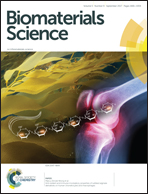Impact of the biomolecular corona on the structure of PEGylated liposomes†
Abstract
Driven by the promises of gene therapy, PEGylated cationic liposomes (CLs) have been investigated for decades, but their use in the clinical setting is far from established. Such a dichotomy is due to several factors that have been ignored over the last two decades. The hardest challenge seems to occur when PEGylated CLs come into contact with a physiological environment (e.g. the blood). Recent evidence has demonstrated that PEGylation does not completely prevent protein binding (as believed so far), but a biomolecular shell, termed “biomolecular corona” (BC), covers the liposome surface. Here we show that the formation of a BC not only affects the surface properties of PEGylated CLs, but also, and significantly, their bilayer structure thus impairing their ability to safely deliver their cargo to the target site. Therefore, a mechanistic understanding of the structures emerging from liposome–protein interactions may represent a truly new paradigm for the clinical translation of PEGylated CLs.



 Please wait while we load your content...
Please wait while we load your content...